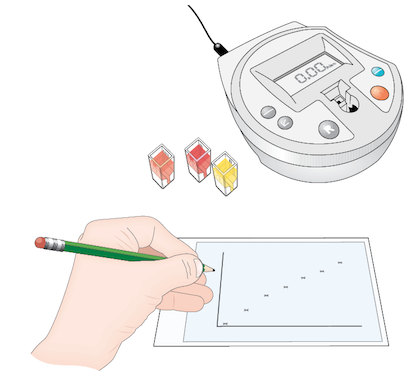DNSA reagent base

Post-16 Biology specifications in England require students to use ‘appropriate instrumentation to record quantitative measurements, such as a colorimeter …’. Most biology specifications also suggest that students carry out practical investigations of enzyme activity. We suggest that the DNSA (3,5-dinitrosalicylic acid) test, a quantitative measure of reducing sugars, is used in this context.
PRACTICAL PROTOCOL
DNSA is more sensitive and easier to use than Benedict’s reagent. Used with a colorimeter, it is ideal for measuring the action of enzymes such as invertase, cellulase and amylase where reducing sugars are produced. Thus it helps to meet two of the important practical requirements of the current (English) biology specifications.
HOW IT WORKS
On heating with reducing sugars, the 3-nitro (NO2) group of DNSA is reduced to an amino (NH2) group.

The colour of the reagent changes from yellow to orange or red, depending upon the concentration of reducing sugar present. The DNSA test can detect concentrations of glucose between 0.5 mM (0.09% glucose w/v) and 40 mM (0.72% glucose w/v).
PREPARATION
The DNSA reagent base is supplied without sodium hydroxide. This is because we are unable to send liquids containing sodium hydroxide in the post. You will have to add sodium hydroxide solution to the liquid supplied before it can be used. Do this as follows:
- Wear eye protection (goggles or safety glasses), protective gloves and a lab coat or apron.
- Using the 10 mL syringe supplied, add 20 mL of 2 M sodium hydroxide (NaOH) to the bottle containing the yellow-coloured DNSA mixture. The colour of the liquid will change from opaque yellow to clear, bright orange. [2 M NaOH contains 0.80 g of NaOH in 100 mL of solution.]
- Top up with 13 mL of distilled or deionised water to a final volume of 100 mL.
- Ensure that the bottle is closed tightly and swirl to mix the contents.
- Apply the new contents/safety label to the bottle, covering the existing label.
- If there are a few undissolved yellow lumps in the liquid, leave the bottle to stand at room temperature for an hour or so or overnight until all of the solids have dissolved.
HOW TO USE IT
This is a rough outline of the protocol, which you may need to adapt according to the circumstances of your experiment.
For each sample to be tested:
- Mix 0.3 mL of DNSA reagent with 0.3 mL of the solution to be tested.
- Heat the mixture by standing it in a beaker of freshly-boiled water (e.g., from a kettle) for 5–10 minutes. There is no need to boil the mixture. If reducing sugars are present, the liquid will change colour from yellow to orange or red.
- Dilute the mixture by adding 3 mL of distilled or deionised water to it.*
- Place the liquid in a cuvette and read the absorbance at 500–560 nm (using a green light or filter; the ideal wavelength to use is 540 nm).
* If the concentration of reducing sugar in the mixture is high, the sample may need to be diluted further before the absorbance can be read in a colorimeter.
STORAGE
The DNSA reagent, with or without added NaOH, should be stored at room temperature. It can be stored for at least 24 months. Note that the mixture without NaOH may separate into two layers; this does not affect its performance and once NaOH has been added, the mixture is stable.
SAFETY

DANGER. Causes skin irritation and serious eye irritation. Harmful if swallowed. See Safety Data Sheet for further advice.
IMPORTANT
THE SAFETY DATA SHEET SUPPLIED WITH THE PRODUCT REFERS TO THE DNSA REAGENT BASE BEFORE YOU HAVE ADDED SODIUM HYDROXIDE TO IT. ONCE THE SODIUM HYDROXIDE HAS BEEN ADDED, THE CONCENTRATION OF SODIUM HYDROXIDE IN THE COMPLETE DNSA REAGENT IS 0.4 M. THIS CONCENTRATION OF SODIUM HYDROXIDE CAUSES SKIN IRRITATION AND SERIOUS EYE IRRITATION. PROTECTIVE GLOVES, EYE PROTECTION AND PROTECTIVE CLOTHING E.G., A LAB COAT OR APRON SHOULD BE WORN.
SAFETY DATA SHEET
DNSA REAGENT BASE
DNSA reagent base ….. makes 100 mL ….. £20.00 (GBP)
ORDERING
All of the prices on this page are in GBP and do not include Value Added Tax (VAT). This tax applies within the European Union only. Postage and handling must also be paid on orders from outside the United Kingdom. Details of how to order are given on the price list and on the Ordering web page.

